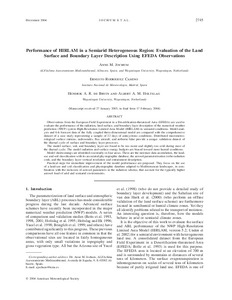Por favor, use este identificador para citar o enlazar este ítem:
http://hdl.handle.net/20.500.11765/11659
Performance of HIRLAM in a semiarid heterogeneous region: evaluation of the land surface and boundary layer description using EFEDA observations
| Título : | Performance of HIRLAM in a semiarid heterogeneous region: evaluation of the land surface and boundary layer description using EFEDA observations |
| Autor : | Jochum, Anne M.; Rodríguez Camino, Ernesto

|
| Palabras clave : | HIRLAM; Boundary layer; Radiation; Land surface |
| Fecha de publicación : | 2004 |
| Editor: | American Meteorological Society |
| Citación : | Monthly Weather Review. 2004, 132, p. 2745–2760 |
| Versión del editor: | https://doi.org/10.1175/MWR2820.1 |
| Resumen : | Observations from the European Field Experiment in a Desertification-threatened Area (EFEDA) are used to evaluate the performance of the radiation, land surface, and boundary layer description of the numerical weather prediction (NWP) system High-Resolution Limited Area Model (HIRLAM) in semiarid conditions. Model analysis and 6-h forecast data of the fully coupled three-dimensional model are compared with the comprehensive dataset of a case study representing a sample of 22 days of anticyclonic conditions. Distributed micrometeorological surface stations, radiosondes, flux aircraft, and airborne lidar provide a unique validation dataset of the diurnal cycle of surface and boundary layer processes. The model surface, soil, and boundary layer are found to be too moist and slightly too cold during most of the diurnal cycle. The model radiation and surface energy budgets are biased toward more humid conditions. Model shortcomings are identified essentially in four areas. These are the moisture data assimilation, the land-use and soil classification with its associated physiographic database, the aerosol parameterization in the radiation code, and the boundary layer vertical resolution and entrainment description. Practical steps for immediate improvement of the model performance are proposed. They focus on the use of a land-use and soil classification and physiographic database adapted to Mediterranean landscapes, in combination with the inclusion of aerosol parameters in the radiation scheme, that account for the typically higher aerosol load of arid and semiarid environments. |
| Patrocinador: | The EFEDA 1991 field phase was cofunded by the European Commission under its Environment Program (Grant EV5VCT93- 0271). |
| URI : | http://hdl.handle.net/20.500.11765/11659 |
| ISSN : | 0027-0644 1520-0493 |
| Colecciones: | Artículos científicos 2000-2004 |
Ficheros en este ítem:
| Fichero | Descripción | Tamaño | Formato | ||
|---|---|---|---|---|---|
| mwr2820.1.pdf | 279,59 kB | Adobe PDF |  Visualizar/Abrir |
Los ítems de Arcimis están protegidos por una Licencia Creative Commons, salvo que se indique lo contrario.





